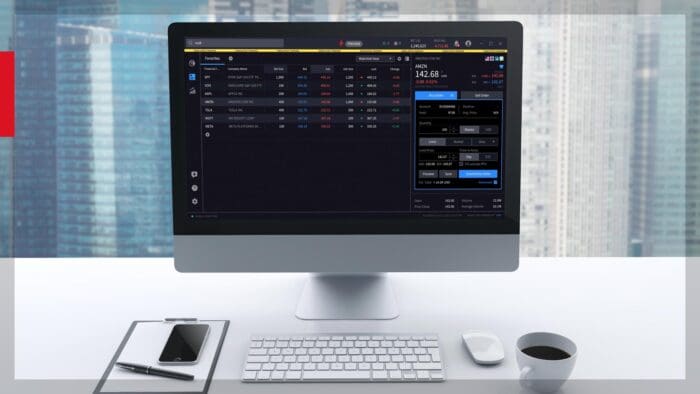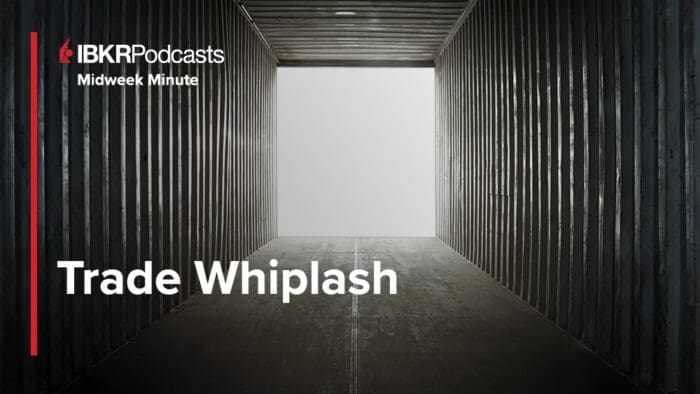Back by popular demand — we take an even deeper dive into at-the-money straddles with Market Chameleon’s Dmitry Pargamanik. Learn how traders use historical benchmarks, volatility rankings, and probability of touch to sharpen their edge in options trading. This episode builds upon our previous discussion in Analyze This [ATM Straddle].
Summary – IBKR Podcasts Ep. 246
The following is a summary of a live audio recording and may contain errors in spelling or grammar. Although IBKR has edited for clarity no material changes have been made.
Jeff Praissman
Good afternoon, everyone. This is Jeff Praissman in the IBKR Podcast Studio. It’s my pleasure to welcome Market Chameleon’s Dmitry Pargamanik. How are you?
Dmitry Pargamanik
Hey Jeff. Thanks for having us.
Jeff Praissman
Oh, it’s my pleasure. I love having you swing by on the second Tuesday of every month after you do your monthly webinar with us. It’s always a pleasure to have you in and take a further dive into it, maybe a little bit differently on a conversational level so that the podcast audience can enjoy it.
And today, we talked about at-the-money straddles in the webinar, and we’re gonna further that conversation. I know we discussed at-the-money straddles in our episode 226, Analyze This, but we’re gonna go even further into that topic because it was so well received.
But can we just start with a quick review of the basics for our listeners that may be joining us now and not super familiar with option combinations? What exactly is a straddle, and maybe more specifically, what’s an at-the-money straddle?
Dmitry Pargamanik
Yeah, so the at-the-money straddle is an option strategy. And this particular strategy involves simultaneously buying and selling the call and the put on the same strike and the same expiration — for a strike that’s the closest to where the stock price is. So that’s what makes it at the money. Perfect at the money is where the stock and strike perfectly match, but in this case, you’re not gonna always get a strike that’s exactly the stock price.
But this particular strategy is important to traders because it’s a way to express your opinion, or to hedge, or to take advantage of a potential opportunity that involves stock volatility and movement — not in a directional way, but in the magnitude of the move. And it’s important for traders to understand that because that creates more tools in your arsenal — more tools to trade the market in different ways that are not necessarily directional of going up or down.
So yes, the straddle is one of the more important strategies out there that traders use.
Jeff Praissman
And so I guess that makes sense to use at the money, right? Because both the calls and the puts are theoretically going to be very close to maybe a 50 delta each, depending on the timeframe. But they each will have the equal chance of movement, whether the stock goes up or down.
If you’re long it, you want it to move. And if you’re short it, you simply want it to stay put, right?
Dmitry Pargamanik
Exactly right. Think of it this way: you have this premium that you pay, so you need it to move away from the strike by a big enough magnitude if you own it — to cover the cost of what you paid for the call and the put. So the call will go up in value if the stock goes up. The put will go up in value if the stock goes down. But it has to do it by a big enough percentage move that it covers the cost of both those options.
And on the flip side, like you said, if you sell it and the stock doesn’t move, then the options will decay and eventually they’ll expire. So that’s the idea behind the straddle.
Jeff Praissman
And in the webinar, we really discussed screening for these at-the-money straddles. When analyzing, are there any benchmarks you can use to help with the analysis?
Dmitry Pargamanik
Exactly. And what’s helpful is, by having benchmarks, you can narrow down potential candidates because that helps you compare the market prices versus a benchmark and see how much they diverge. And we typically, because it’s movement or volatility, we’ll look at two different benchmarks.
One, we’ll look at a benchmark of historical moves — measure those — and another, we’ll look at implied volatility, historical implied volatility, and compare the implied volatility versus current, which are important benchmarks. And it’s a quick way, when you’re looking at different straddles, to make an evaluation.
Jeff Praissman
Yeah. Could you dive into how historical move comparisons help you and how you use it in the screening? And also talk about the historical win rate and the probability of touch — and this kind of terminology that our listeners may not be super familiar with?
Dmitry Pargamanik
Yeah. So when we look, let’s say, at a straddle itself — when we look at options or forward-looking or markets-anticipated move — based on those option prices, if we have, say, a straddle which implies a move of 10%, for example, in the next 10 days (because options have an expiration), so you have days to expiration.
And if we look at a straddle that has an implied move of 10%, it really means that, let’s say the stock is 100, your breakeven is either 110 or 90. It has to move 10% in either direction. And of course, if you’re long it, you want it to go higher. If you’re short it, you want it to not move.
And the question would be, then, if we have this 10-day period, how often does this stock, in a 10-day period — or how much does the stock actually move in a 10-day period? Because obviously, a stock in a smaller period — let’s say one second — is not gonna move as much as it can move in a minute, or an hour, or 10 days, or 100 days.
So the question is: over a 10-day period, what type of stock moves in either direction have we seen? And by looking at history, we could take an average. Sometimes it might go up 5%, sometimes down 10%. But if we take an average, we could compare that to where the implied moves are to see how far away is it from the average — is it very high or very low away from that historical average?
And I’m glad you mentioned the win rate because the historical average gives us a benchmark that’s useful. But of course, an average could get pulled up by a very big outlier, in either direction. So the historical win rate is another measurement to say, all right, we have this average move, and now we see the implied volatility 10%, but how often in our historical observations — let’s say we have 100 observations — how often in those 100 observations did the stock move beyond 10%, let’s say?
So this will give us a better idea of not only the average but the frequency of those types of moves. Are they seldom? Are they frequent? So that would be the historical win rate.
If we’re measuring it from the buy side, let’s say, then we have this concept — probability of touch. And the idea there is, in a 10-day period — if we’re looking at observations over a 10-day period — a stock could start out at one price, move around a lot, and then at the end of 10 days come back to unchanged.
So you have the straddle. And the question is: how often, even in between, right — let’s say in those 10 days, the stock could have started at 100 and ended at 100 in 10 days — day one, day two, day three — it could move around. How frequently did it even touch that 10%? That would be a higher number than just over a 10-day period because you have intraday volatility and day-to-day volatility. So probability of touch is — at any point in time within that 10 days — how often would it have moved 10%?
So this gives you a different historical perspective or frequency of times that the stock has behaved that way or moved that amount. And all these different metrics just help us make a better evaluation in that, by looking at that straddle and comparing it to a historical perspective of stock moves.
Jeff Praissman
And what about implied volatility rankings? How do you utilize that information in your screeners?
Dmitry Pargamanik
So that’s another way we could benchmark and compare the current straddle value. And of course, the straddle itself could be traded a couple different ways, but typically you could, of course, just buy or sell the straddle and wait till expiration to see if the stock will move far enough, right? Or not, if you’re selling.
Or you can trade the Black-Scholes model, right? By hedging your deltas. And then with that strategy, you’re trading the realized volatility — the daily realized volatility versus implied volatility. And if you’re using that strategy, of course we want to see the implied volatility benchmark.
And in this situation, what we’ll do is we’ll say, okay, let’s look at the historical option prices — not even the stock like we were talking about. We’re gonna look at the historical option prices and look at what the implied volatility was historically for a similar straddle.
So if we’re looking at a 10-day straddle, we’d have to go find 10-day straddles. If we’re looking at a 5-day straddle, we’d have to go look at a 5-day straddle. If we’re looking for an earnings situation, we’d have to do earnings. If it’s not earnings, we’d have to go back in history, look at the observations that we found — similar circumstances — and then what are the implied volatilities of a straddle historically with similar conditions?
There’s not always going to be an exact match, but we could take an average and see how far away we diverge from the average at this point. That is another benchmark to look at. Or you could use both, right? Sometimes you might want to just use both benchmarks to see where you’re at.
But that is another benchmark we could use to make a quick evaluation of the value — the current value — of the straddle.
Jeff Praissman
And you covered this next question in great detail in these last two answers, but maybe just overall, if you could just summarize the benefits of using these benchmarks — maybe one or two sentences — just for our listeners in general. Obviously you just went over it in really good detail.
Dmitry Pargamanik
For sure.
Jeff Praissman
A takeaway summary.
Dmitry Pargamanik
So the most useful part of that benchmark is we want to see how far away it’s diverging — because if there’s something unusual going on, it could indicate that maybe the markets might be indicating something you didn’t even think about.
But it’s a quick way to look at the current markets and say: are we on the low end of the historical range? Are we on the higher end of the historical range? Are we right at the average? Because volatility is considered mean-reverting. So how far away are we on the straddle relative to history?
And of course, when we do relative comparisons — even within a screener — you could create a group of stocks that are similar and compare their relative values. Are they all on the low end? Are they all on the high end? Or do we have a mix of low-end straddles that are priced lower and higher within the same group of stocks that you created?
So I think that’s the biggest benefit of it, and it’s a quicker way to make those evaluations — especially in something like a screener.
Jeff Praissman
No, absolutely. And of course, with everything in the markets, nothing’s guaranteed 100% to be successful. So there’s always risk and reward. What are some of the risks and limitations to analyzing at-the-money straddles and using that information?
Dmitry Pargamanik
Yeah, there’s always imperfect information. And the straddles themselves — they’re forward-looking instruments. And history is just the guidance, right? Whatever happened in history, we don’t know going forward.
But you still have to go do research on why a straddle might be priced very low or very high — and it might be justified, right? There might be a very good justification to do it. Sometimes a straddle that looks very low could be justified — let’s say it’s a takeover target, right?
And if a stock gets taken over for a certain price and the stock is trading at that price, it’s probably not gonna move like it did in history, right? Because it’s gonna just get taken over for this price and those options will go away.
It could be priced very high on the higher end, and there could be a special situation — whether it’s based on the market or specific to that stock — and it could be very justified. And something that we haven’t even seen in history — or we might not even be able to price it because we haven’t seen it in history.
Maybe a stock is anticipating approval for a drug for the first time or has a special lawsuit. So there are certain instances where it is justified, and you could potentially even find that justification, right? But you do need to keep that in mind, and you have to do those extra steps.
Jeff Praissman
Dmitry, as always, this has been great. Are there any other final thoughts you’d like to leave our listeners with?
Dmitry Pargamanik
Yeah, I think the two takeaways from today are that if you’re trading options — one is to learn how to utilize options in different ways. Not just directionally — buying a call or buying a put — but you could really combine them.
The powerful thing about options is that you could spread them and combine them to create certain strategies. And the straddle is one good example where it’s a non-directional trade that is based on the magnitude of the move in either direction — or volatility.
And also to look at how you could use screeners — using screeners to your advantage to find potential opportunities or narrow down candidates. As options traders, that strategy and these tools become critical — and knowing how to use them.
Jeff Praissman
And thanks again for stopping by the Interactive Brokers Podcast Studio. You can find Dmitry every day on their Market Chameleons YouTube channel, as well as find their past webinars, podcasts, and articles on our website under Education and Contributors — just look for Market Chameleon.
Until next time, I’m Jeff Praissman with Interactive Brokers Podcasts.
Disclosure: Interactive Brokers
The analysis in this material is provided for information only and is not and should not be construed as an offer to sell or the solicitation of an offer to buy any security. To the extent that this material discusses general market activity, industry or sector trends or other broad-based economic or political conditions, it should not be construed as research or investment advice. To the extent that it includes references to specific securities, commodities, currencies, or other instruments, those references do not constitute a recommendation by IBKR to buy, sell or hold such investments. This material does not and is not intended to take into account the particular financial conditions, investment objectives or requirements of individual customers. Before acting on this material, you should consider whether it is suitable for your particular circumstances and, as necessary, seek professional advice.
The views and opinions expressed herein are those of the author and do not necessarily reflect the views of Interactive Brokers, its affiliates, or its employees.
Disclosure: Market Chameleon
The information provided on MarketChameleon is for educational and informational purposes only. It should not be considered as financial or investment advice. Trading and investing in financial markets involve risks, and individuals should carefully consider their own financial situation and consult with a professional advisor before making any investment decisions. MarketChameleon does not guarantee the accuracy, completeness, or reliability of the information provided, and users acknowledge that any reliance on such information is at their own risk. MarketChameleon is not responsible for any losses or damages resulting from the use of the platform or the information provided therein. The 7-day free trial is offered for evaluation purposes only, and users are under no obligation to continue using the service after the trial period.
Disclosure: Options Trading
Options involve risk and are not suitable for all investors. For information on the uses and risks of options, you can obtain a copy of the Options Clearing Corporation risk disclosure document titled Characteristics and Risks of Standardized Options by going to the following link ibkr.com/occ. Multiple leg strategies, including spreads, will incur multiple transaction costs.













![Analyze That [ATM Straddles] Part 2](https://www.interactivebrokers.com/campus/wp-content/uploads/sites/2/2025/04/podcast-16x9-7-700x394.jpg)




Join The Conversation
For specific platform feedback and suggestions, please submit it directly to our team using these instructions.
If you have an account-specific question or concern, please reach out to Client Services.
We encourage you to look through our FAQs before posting. Your question may already be covered!